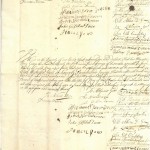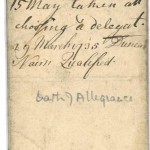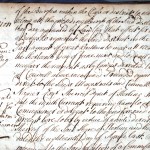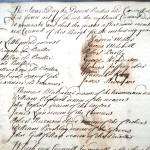This paper surviving from the 18th century gives a unique insight into the voting system before the reforms of 1832, anxieties relating to the Jacobites on the part of the British monarchy and to the election of officers in a Scottish Royal Burgh. This item is a good example of how much information can be contained in just one original document and highlights the importance of archive material to our understanding of the past.
There are two oaths given here, both to King George II, the shorter one is of simple allegiance to the King, the longer one states explicitly that the oath-taker rejects the claim to the throne of “…the pretended Prince of Wales now taking upon him the title of King of this Realm and his adherents and all other enemies who either by open or secret attempts Shall disturb or disquiet his Majesty in the possession and exercise thereof”. This refers to James Francis Edward Stuart, known as the ‘Old Pretender’, son of the deposed James VII of Scotland and II of Great Britain. His claim to the British throne was recognised by the Papacy and various royal households in Europe, and supporters of his interests were numerous in Scotland and other parts of Britain. Rebellions in his name had already been suppressed in 1705 and 1715 and this version of the oath of allegiance had been current since the death of his father, James II and VII and of Queen Anne, both in 1701.
The oath of allegiance to the King was taken by the Provost, Bailies and Councillors of Stirling Burgh in May 1734 when they were convened to elect a delegate to attend the Commission to choose a new Member of Parliament for Great Britain. The voting system at that time was very different to what we have now. Only men who owned property worth over £4 a year were permitted to vote and there were comparatively few of these even in a prosperous place like Stirling. After the Act of Union of 1707, Scottish Burghs elected 14 Members of Parliament with the remainder of Scotland’s 45 MPs being chosen by County Constituencies. The Burghs were divided into constituency groups with each Council choosing a Commissioner delegated to vote for the Parliamentary representative, so each Burgh received just one vote in this process. Stirling was in a group with Culross, Dunfermline, Inverkeithing and Queensferry. The Council minutes for the 15th May 1734 record that the Provost, Robert Wingate, was chosen as the Commissioner on this occasion.
The oath is signed by the Provost of Stirling, the Bailies or Magistrates, the Dean of the Guildry, the Deacons of the Incorporated Trades of Stirling and the Councillors. These people were the power base of the Burgh, the richest and most influential citizens and until the electoral reforms of 1832, they were the only people who really had much of a say in the way that the Burgh and the country was run. You can see that some of these men were better educated than others by the handwriting in their signatures. Education was very much a privilege of the ruling classes at this time and literacy levels everywhere were low, many people signing documents with a simple cross annotated by the clerk with the phrase ‘their mark’ after their name. These officials of the Burgh were elected from among their number every year and a record of their elections is held as part of the Council’s archives.



